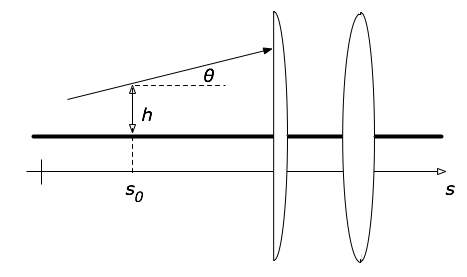
Problems for
Intermediate Methods in Theoretical Physics
Edward F. Redish
 |
Problems for Edward F. Redish |
|
An interesting vector space is the one used in geometrical optics. It allows the treatment of lens combinations in complex systems algebraically without requiring complex ray tracing. The simplest example of this is Gaussian optics. The rays are assumed to remain close to a central axis and stay at small angles to that axis so that the small angle approximation can be used. An "optical bench" with tow lenses and a ray is shown in the figure at the right. The optical axis is drawn as a heavy line. The "ray" is described by giving the height of the ray above (or below) the optical axis and the angle it makes to the horizontal as a function of position. Thus, to describe the ray when it gets to the point s0, we could specify the two numbers h(s0) and θ(s0). We can write these together as a vector:
|
 |
As the ray propagates through the system, this vector changes. If we keep the angles all small so the small angle approximations hold (sin θ and tan θ ≅ theta), then the propagation of the ray through the system can be described by matrices.
(a) Show that the set of possible ray vectors is a linear space but not an inner product space.
(b) Show that the propagator, that is, the matrix that changes the vector r(s) into the vector r(s+d) when the ray is moving only through empty space is:

(c) Show that at a thin lens with focal length f the matrix that transforms the ray on the left side of the lens to the refracted ray on the right side of the lens (ignoring the thickness of the lens) is

(Hint: Recall that the focal distance is defined as the point where rays hitting the lens parallel to the axis are bent to cross the axis.)
| University of Maryland | Physics Department | Physics 374 Home |
|---|---|---|
 |
 |
 |
Last revision 28. October, 2005.